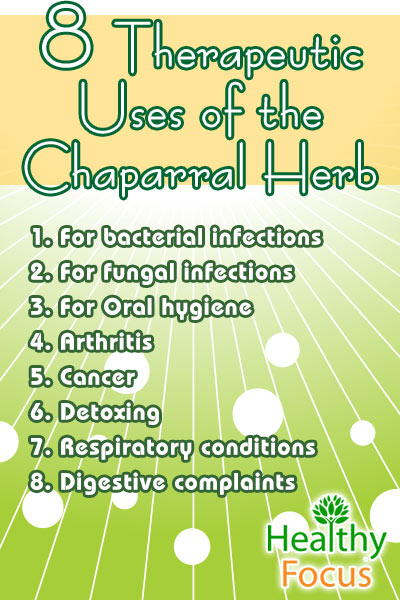Last Updated on January 21, 2018 by Marc Seward
What is Chaparral?
Chaparral is an herb with a long tradition of medicinal use. It is also known as creosote bush because of its strong smell that resembles creosote or by its scientific name ‘larrea divaricata’. Despite its most commonly given name, the herb does not actually grow within the chaparral.
Chaparral is found in abundance across the desert areas of the Southern United states as well as Northern Mexico and arid regions of certain South American countries like Bolivia and Argentina.
The bush is medium sized growing up to 6 meters in height with dark green resinous leaves and yellow flowers. The chaparral products sold by health stores for medicinal purposes are usually made from the leaves and the twigs of the shrub.
What are the medicinal uses of chaparral?
Chaparral has long been used by Native Americans for a variety of purposes including stomach cramp, arthritis, respiratory disorders and kidney stones. It is said to have excellent antioxidant properties which can protect against a number of diseases and help stunt some of the signs of aging.
According to experts in the field, chaparral is a strong natural antibacterial agent which can be used to treat infections as well as wounds and cuts. It is also an ingredient in natural weight loss teas and has been used for deodorant purposes.
It is important to point out however that there are some serious safety concerns regarding the use of chaparral especially with regard to its supposed damaging effect on the liver.
Specific uses of chaparral
 1. For bacterial infections
1. For bacterial infections
One of the most important uses of chaparral is to treat a variety of infections including bacterial skin infections and internal infection. It is a very effective treatment for staph infections although how effective it proves will depend on the type of staph and the severity of the condition.
To treat a staph infection, fill a basin or bowl with a strong chaparral tea solution and soak the affected area. If the affected area of your skin is not easy to soak, you can make a hot compress instead and apply that to the affected area. According to some experts and anecdotal evidence, it can also be used to prevent and treat dandruff.
You can also use chaparral in the same way to deal with minor cuts and wounds while drinking a tea or taking chaparral in oral forms can help deal with stomach complaints caused by bacterial infections.
2. For fungal infections
If you are suffering from a fungal infection of the skin such as jock itch, applying a strong solution of chaparral may be able to help treat the problem. As well as having strong antibacterial properties, chaparral is also an effective natural antifungal herb. It can be used to treat toenail fungus by simply soaking your feet and toes in a bowl full of strong chaparral tea or by applying a tincture to your toes and toenails.
3. For Oral hygiene
If you have dental problems or infections then chaparral is an excellent treatment choice because of its ability to rid you of the oral bacteria which leads to gum disease and tooth decay. You can apply a chaparral solution directly to the affected areas of your mouth or simply gargle with it. The flavor and smell of chaparral is certainly not to everybody’s taste so you might want to follow up with a menthol mouthwash to get rid of any unpleasant after taste.
4. Arthritis
Because of it anti-inflammatory properties, the herb has been indicated for the treatment of inflammatory conditions such as rheumatism and arthritis as well as for the treatment of certain inflammatory skin conditions. There is historical and traditional evidence of its use in this regard but it should be noted that there is no evidence of its efficacy.
5. Cancer
When looking into alternative cancer treatments it is likely that you will quickly come across reference to chaparral. A Google search of chaparral and cancer brings hundreds of hits but there is little to no conclusive evidence that it works beyond anecdotal evidence relayed by doctors and patients.
If it does work, there is certainly no expert consensus regarding the mechanisms but many believe that its effectiveness owes much to its NDGA content. NDGA or nordihydroguaiaretic acid is an antioxidant which is believed to protect tissue and cellular damage resulting from exposure to carcinogens.
6. Detoxing
Because chaparral contains effective antioxidant properties, it may be useful in cleansing the blood and slowing down cellular decay. Drinking a cup of chaparral tea on a regular basis or taking it in one of its other supplementary forms may well help ward off the damage caused by the free radicals that we come across daily and protect the body from disease. Unfortunately, there are reports that chaparral can have the opposite effect and result in liver damage.
7. Respiratory conditions
When drunk in the form of tea, chaparral can be used to effectively alleviate respiratory complaints like colds, bronchitis and sinus infections. It has expectorant and anti-inflammatory properties that help clear the airways and reduce the build-up of mucus.
8. Digestive complaints
Drinking chaparral tea or taking it in one of its other supplementary forms can aid a number of digestive complaints including excess gas, bloating, cramps and diarrhea.
How to use Chaparral
Chaparral is readily available in numerous forms including the following:
- Tinctures
- Salves
- Tea made by infusing the herb in hot water. You might well need to add some honey because if you are drinking it rather than using it as a soak, it can be difficult to palate.
- Capsules may be one of the best options for internal use as it will neutralize the powerful flavor without you missing out on its therapeutic goodness.
- You can make a compress by soaking a cloth in a strong tea mixture and applying it to the body.
- You can also soak any affected body part in a tea made with chaparral.
Dosage
There is very little concrete information regarding the effective and safe dose of chaparral but caution should be exercised since liver damage has been reported when taking the herb from 1.5 grams to 3.5 grams a day. It is considered good practice to begin with a very low dosage before building up gradually to a higher dose.
As regards topical application, there is less of a concern and it can be applied in liquid form to the skin several times daily unless you experience a reaction. Because it is considered to be such a powerful herb, it is very important to speak with your doctor before using it, especially if you are planning to take it internally.
Precautions
- Chaparral is not considered to be safe when taken internally and was taken off the FDA’s generally regarded as safe (GRAS) list all the way back in 1968.
- There have been a number of reported incidents of liver damage from the use of chaparral.
- Chaparral should not be used by people with poor kidney function because of the high risk of toxic damage.
- Pregnant women and nursing mothers should avoid using chaparral.
- It is possible for chaparral to induce a skin reaction when applied topically.



Leave a Reply
You must be logged in to post a comment.